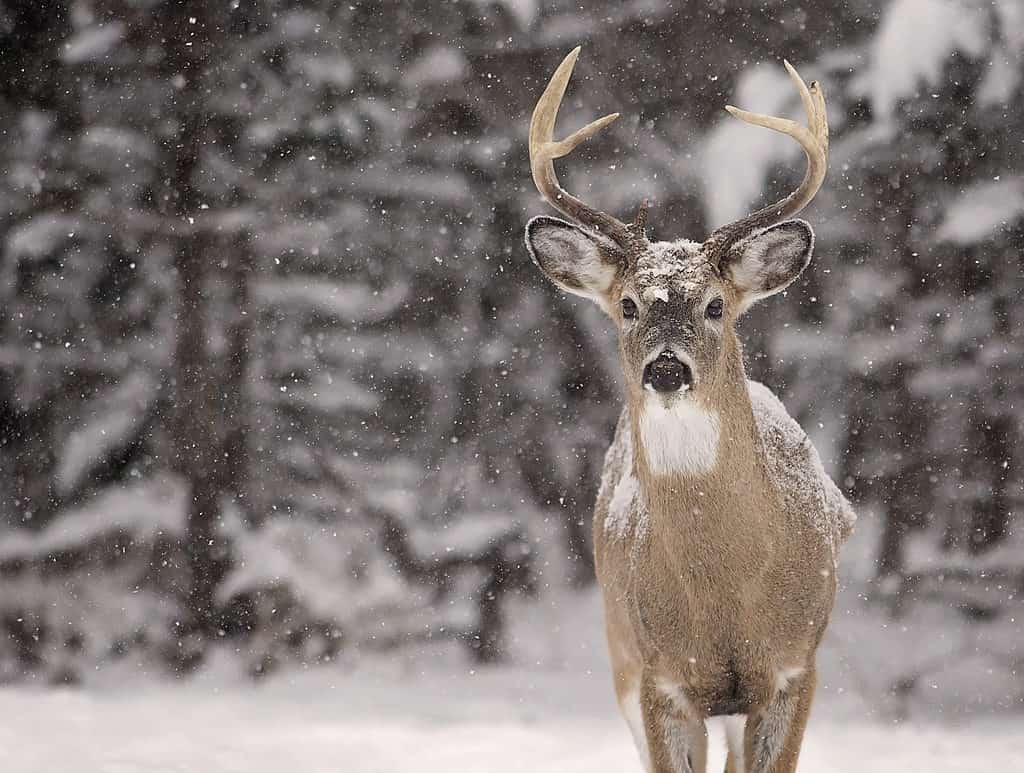Snowfall in October isn’t unheard of to Vermonters, but heavy snow is uncommon. The biggest October snowstorm in Vermont shocked residents 30 years ago. As I’d just moved into my new house and eagerly awaited our first trick-or-treaters, I remember this storm very vividly.
October kicks off what’s locally known as “stick season.” Fall foliage puts on a show before leaves fall to the ground a few weeks later as trees enter their winter-long dormancy. Roxbury the closest town to Vermont’s center, and in October, the area sees an average high of 57º F and a low of 41º F. It’s not conducive to heavy snow. Vermonters expect to be raking leaves in the fall not shoveling snow.
The Storm of Halloween 1993

Halloween of 1993 was an uncommon event where trick-or-treaters had to walk through snow.
©Svetlana Popova/iStock via Getty Images
While there was a storm that hit Vermont on October 10, 1925, that dropped 5 inches of snow, it wasn’t as big as an alleged blizzard that hit the Northeastern U.S. in 1836. That storm, however, isn’t officially on record, though it allegedly dropped 12 inches in Vermont. Those are other Vermont snowstorms worth noting, but there’s one that many Vermonters still talk about.
I’m focused on official records from the National Weather Service in Burlington, and that makes the biggest storm on record one that hit on Halloween in 1993. Dressed in heavier winter clothing over their costumes, children trudged through the snow to get to their neighbors’ front doors. That night, Vermonters watched as snow fell and reached depths of 9 inches.
Temperatures reached a high of 52º F on the rainy Sunday afternoon, which was common. However, the nighttime temperatures dropped to 33º F, and rain switched to wet, heavy snow that lasted through the night. Vermonters had to get shovels out to clear sidewalks and driveways before heading out to work. With high temperatures in the 30s for the next two days, the snow stuck around, but there was no more significant snow that year.
Wildlife During a Vermont Snowstorm

Snow makes it hard for deer to camouflage in hunting season.
©iStock.com/Lynn_Bystrom
When snow falls, it’s harder for deer and other Vermont animals to find food. Deer use their antlers to push away snow, which makes grass accessible. Turkeys scratch at the snow to find any bugs burrowing in the fallen leaves. Snow does more than make it harder to find food. There’s another issue that snow creates for Vermont’s wildlife, and that’s the annual Vermont hunting season that proceeds Thanksgiving.
Deer and turkey hunting seasons take place during certain weeks in October and November. Some weeks are open to archery and others allow guns. Snow makes it harder for the animals to hide as the stark white eliminates the chances of blending in, and animal tracks remain in the snow. While snow benefits hunters, it’s problematic to animals, so they hide in thick brush as much as they can.
When snow falls earlier than usual, animals that forage for the winter run out of time to stock up. It also impacts reptiles and amphibians that haven’t gone into hibernation yet. Snapping turtles hatch from their eggs and start their journey to find a permanent habitat in late September, early-October. If snow falls before hatchlings make it to a pond or river with enough silt, it makes that trip challenging.
The Impact of Vermont October Snowstorms

Snowstorms are an expected part of a typical New England winter.
©iStock.com/kevinmwalsh
The motto “Vermont Strong” aptly describes the state’s residents. Earlier that same year, a March snowstorm dropped over 22 inches of snow, making it the eighth biggest snowstorm in Vermont. In comparison, the Halloween snowstorm wasn’t that bad.
As a result, the Halloween snowstorm didn’t impact residents too much. We got our shovels and snowblowers out earlier than usual. Vermonters who use winter tires made appointments to switch over from summer or all-season.
Children who did brave the snow, rain, and cooler temperatures received plenty of candy from their neighbors, and in a few days, temperatures returned to normal and the snow went away. In March of 1994 the next record-breaking storm hit and dropped almost 18 inches, making it the 18th biggest Vermont snowstorm. Those bigger storms impact Vermonters the most, as road crews work tirelessly to plow, sand, and salt Vermont’s roads. It’s also part of living in New England, so we’re used to it.
The photo featured at the top of this post is © iStock.com/steverobertsphotography
Thank you for reading! Have some feedback for us? Contact the AZ Animals editorial team.






